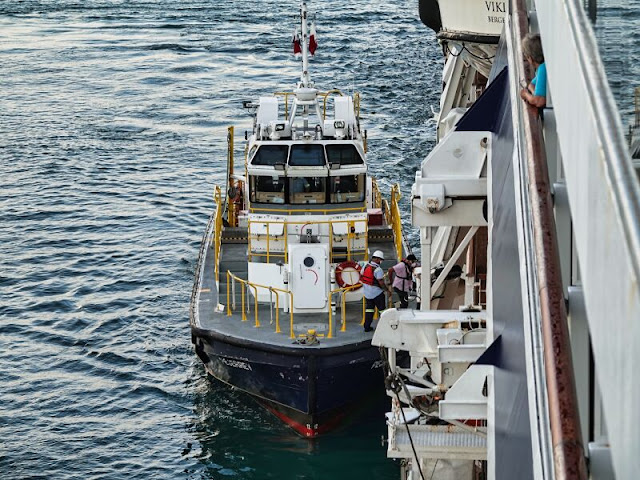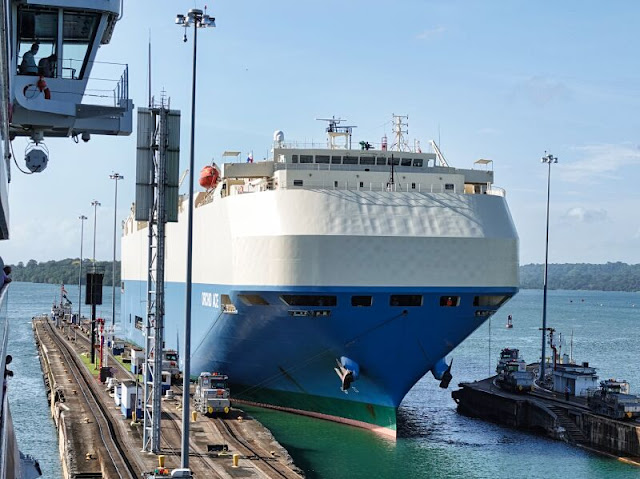Cruise day: 8/152
Ports days: 3
Sea days: 5
Countries: 3
Continents: 1
Ports: 3
One of two posts today
In case you didn't notice, the title of this post, at least after the hyphen and before the parentheses, is a palindrome. This is the first of two posts today. The second will be dedicated to wildlife. This one is specific to the transit of the canal.
Someone on a Cruise Critic board nicknamed Heidi13 corrected several of my statements. I added their comments to the end of this post.
Today's adventure was a full transit of the canal - the Panama Canal, from Colon, where we were docked last night, to Panama City. We entered the canal from the Atlantic around 7:30 AM this morning and exited the canal to the Pacific around 5 PM tonight.
The canal transit consists of passing through three sets of locks for smaller ships like ours, and two sets for the larger mega-ships. The first, the Gatun locks have three locks and consist of three locks where we step up from the level of the Atlantic Ocean to the level of Gatun Lake. After that, we passed through the single Pedro Miguel locks and then the two-step Miraflores locks. In both of those locks, we stepped down, ultimately reaching the lower level of the Pacific Ocean.
Here we are passing under the Atlantic Bridge in Colon. This suspension bridge parks the Atlantic end of the Panama Canal.
There are lots of support vessels for ships that transit the canal. Here, we see the pilot heading to join us.
Most ports require a local pilot to join the ship and assist in directing the ship in/out of port. The canal is no different. Here, you can see the pilot - he's wearing a pink shirt.
The pilot ship pulls alongside, and the pilot literally jumps ship to ship and boards and then proceeds to the bridge. You can certainly tell OSHA is not involved. Once done, the pilot hops back to the pilot ship and leaves.
As we approached the Gatun locks, you can see ships already in the lock system. There are two sets of locks - the historic one that we will go through and the new locks, sized for today's mega-ships.
We noticed this little wave traversing the canal. We surmised that it was an outcome of water flooding out of the lock. It was interesting as this wave moved for a very long distance, undisturbed, and passed our ship.
Once into the lock, every vessel is tethered to six electric trains - two on each side of the front of the ship, and one on each side of the back. These electric trains, called mules, are tasked with centering the ship in the canal to prevent scraping. They do not move the ship forward. The ship uses its own propulsion to move through the locks.
Tugs are also used to help position ships and steer them into the locks. Many times, the tug will accompany the ship through the lock.
This is the door forward of our ship opening, as the water level has been equalized. This allows us to pass into the next lock.
Other ships were in the lock system, heading in the opposite direction.
As the ship rises/lowers in the Gatun locks, the mules go up/down hills that are built into the lock.
At the end of the Gatun lock, a single lighthouse stands guard. This marks the entry into Gatun Lake.
It is amazing to look at how closely these ships fit into the canal.
That was very apparent when this behemoth entered next to us!
There were literally inches of clearance on each side. It is amazing to see a huge ship pass through the locks.
Once into Gatun Lake, we enjoyed the sites.
We continued into the Chagres River where we got steering assistance from a tug.
We approached the Centennial Bridge that leads to the Pedro Miguel locks.
All the locks use the same electric mule centering system. Here we see a worked catching the tether tossed from the ship.
The mega-ships went to the right and headed down the new portion of the canal. They only appear to have a single lock or set of locks to lower them to Pacific level whereas we have two more on the historic side.
This gives you a good visual of how much we drop in the lock.
The lock doors are doubles so one can be taken for repair without affecting the lock operation. The doors are hollow and filled with water.
We left the Pedro Miguel lock and entered Miraflores Lake. This leads to the final lock before the Pacific, the Miraflores lock - another two-step lock.
Once we passed through the final lock, we bid the lock system of the Panama Canal a fond farewell.
We followed a massive container ship that had just passed through the final lock on the new side.
We continued to follow it under the Bridge of the Americas.
There were tons of ships queued up to head to the Atlantic.
We were able to catch some nice views of Panama City before heading out into the Pacific and turning north for Costa Rica.
After a long day of watching and photographing our transit of the Panama Canal, it was time for dinner a The Chef's Table and then to watch a little Michigan-Georgia football. It isn't going well for Michigan as I type this. We may wander up for New Year's festivities before midnight.
Comments Frome Cruise Critic member Heidi13 correcting and clarifying my comments.



















































Happy New Year. ENJOY
ReplyDeletegreat job with your photos. can hardly wait to be there ourselves one year from now. Happy New Year. We look forward to the rest of your photos and posts.
ReplyDeleteI really enjoyed the photos of the canal transit interlaced with your commentary. One without the other wouldn't have been as effective. I felt as though I was there with you. The Panama Canal locks are much more complex than those I have been through in Seattle and along the Danube. The controls in place with use of the mules made me wonder what controls are used in the Suez Canal and whether the similar controls could have helped avoid the debacle this past year where the Evergiven blocked the canal and interrupted supply chains throughout the world. How lucky you are to get to experience both canals on this world cruise.
ReplyDeleteAmazing pictures I now feel I don't have to make the trip to see the panama Canal since you did such a great job. Love that I can travel the world with you. Happy New Year to you and Arlona!
ReplyDeletes
Make the trip - it's worth it! Pictures don[t do it justice. Happy New Year.
DeleteThat was a wonderful description of your day and great photos. It is truly a joy to read your blog. Thank you for doing this
ReplyDeleteThank you for this fabulous virtual trip through the Canal!! We in the frozen Pacific Northwest do so appreciate the visual respite!
ReplyDelete